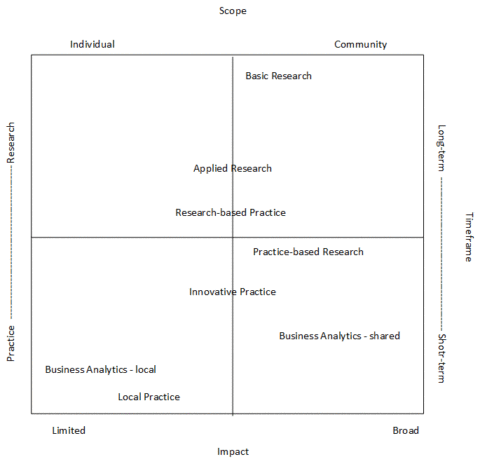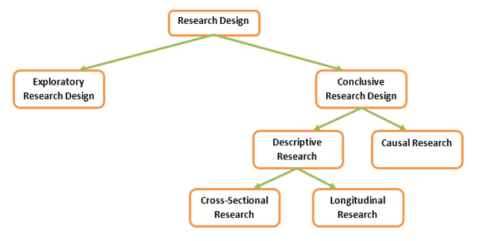Version 1
Prepared by the SPN Research and Innovation Subcommittee of the Steering Committee
Document Lead: Nance McGovern, last updated May 13, 2020
Purpose
The SPN Research and Innovation Continuum is intended to raise awareness and build understanding about the range of activities and categories under the umbrella of research and innovation to inform and enable productive discussions. This document is a backdrop for discussions within and beyond SPN of the scope, agenda, outcomes, and future of research and innovation for digital preservation. In addition to the matrix, the sections provide concepts, considerations, and related resources as context for discussing and using the Continuum.
Research and Innovation Continuum Grid
This is an example of how the examples of research and innovation might be mapped to illustrate their relationship to research and practice, individual to community scope, a long-term to short-term timeline, and limited to broad impact.

Relevant concepts represented in the continuum grid
These are related terms and concepts as background for the Research and Innovation Continuum. There are other terms that could be included, such as exploratory research, surveys, data and related terms (data gathering, data analysis, etc.).
| Term/Concept | Description/Definition | Relevance |
| Basic Research | “… performed without thought of practical ends. It results in general knowledge and understanding of nature and its laws. The general knowledge provides the means of answering a large number of important practical problems, though it may not give a complete specific answer to any one of them.” source | Note: Basic research is important yet less common in applied fields, possibly because it can be harder to justify and therefore fund. |
| Applied Research | “… a form of systematic inquiry involving the practical application of science. It accesses and uses some part of the research communities’ accumulated theories, knowledge, methods, and techniques, for a specific, often state-, business-, or client-driven purpose… Applied research deals with solving practical problems and generally employs empirical methodologies.” source | Note: We are an applied domain and applied research is a natural fit for developing good practice. See Practice-based Research and Research-based Practice |
| Practice-based Research | “… a form of research that aims to advance knowledge partly by means of practice. The type of research is an original investigation undertaken in order to gain knowledge and understanding.” source | Note: This is a form of applied research that is informed by the needs and priorities of a community of practice. |
| Research-based Practice | Practice informed by iterative, ongoing, and systematic exploration and experimentation to identify, investigate, and address issues and problems that emerge in applied domains. [working definition] | Note: This is often used in clinical contexts and it adapts well to our applied domain. Our community practice is developed and demonstrated by Research-based Practice. |
| Business Analytics | “combination of skills, technologies, applications and processes used by organizations to gain insight into their business based on data and statistics to drive business planning.” source | Note: business analytics involves data gathering and analysis that may be conflated with applied or other research forms. |
| Innovative Practice | Developing an understanding of how local practice might be applied in other contexts and demonstrating how outcomes align with or advance community practice. [working definition] | Note: Innovative practice informs community practice by, for example, framing and sharing lessons learned or developing a model for others to use. |
| Local Practice | Individual or organization-specific norms for or descriptions of ways to accomplish specified functions or to achieve specified outcomes. [working definition] | Note: local practice may be perceived as common or good practice even when local practice may be idiosyncratic. |
Research Methodologies Context
There are many ways to categorize and characterize research types. This is a high-level example that maps well to the range of concepts that are mapped to the research and innovation continuum grid. Conclusive or confirmatory research has tended to dominate research undertaken by heritage institutions, though exploratory research is well-aligned with investigating emergent domains and unfamiliar problem areas. Exploratory research is useful when the objective is to help define research problems more clearly, to help identify all possible alternative answers, and/or to help researchers build a deeper hypothesis.

source: http://researchdesignmethod.com/research-design/research-design-classification/
Related concepts that supplement and inform the continuum
These are related terms and concepts as background for the Research and Innovation Continuum. There are other terms that could be included, such as exploratory research, surveys, data and related terms (data gathering, data analysis, etc.).
| Term/Concept | Description/Definition | Relevance |
| Action Research | “… a systematic multi-staged cyclical process, which seeks to improve practice through the implementation of informed and incremental change. Action research is not done in isolation but seeks out opportunities for collaboration and the participation of other agents.” source | Note: Action research is often associated with education, though a form of it has been adapted for use in many applied domains including ours. |
| Basic vs Applied Research | “Applied research is research that seeks to answer a question in the real world and to solve a problem. Basic research is research that fills in the knowledge we don’t have; it tries to learn things that aren’t always directly applicable or useful immediately.” source | Note: There are many ways to classify research, including basic vs. applied. The different understandings of research can introduce ambiguity that confuses discussions within our community. |
| Community Practice | The cumulative knowledge, tools, and expertise to engage in core activities of a community; common and shared understanding that reflects current good practice; grounded in standards and proven practice. | Note: Our community practice is grounded in standards and norms developed since the 1960s and evolved in response to technological and other advances. The concepts mapped on the grid reflect or inform community practice. |
| Constructive Research Methodology | A form of exploratory research that supports the development of practical outcomes, including models. example | note: Suited to digital preservation because it produces solutions to real problems and can be used by individuals or communities |
| Empirical Research | “a way of gaining knowledge by means of direct and indirect observation or experience.” source | Note: empirical is a characteristic of research and innovation that might apply to multiple forms of conclusive research. |
| Innovation | “a new idea, device, or method; the act or process of introducing new ideas, devices, or methods” | Note: In an applied domain, innovation may occur as a result of research or practice activities. |
| Theory | Theory may mean:
1. an hypothesis: “a supposition or proposed explanation made on the basis of limited evidence as a starting point for further investigation” source 2. “a coherent group of tested general propositions, commonly regarded as correct, that can be used as principles of explanation and prediction for a class of phenomena” source |
Note: it is divisive and confusing when people use the first meaning of theory to suggest that what we do is unproven and that there is a need to shift from theory into action. There is a solid foundation of proven and systematically advancing good practice for digital preservation that refutes that faulty framing. See Community Practice. |
Considerations
These are some considerations and caveats as context for this discussion:
- Disambiguation: Research is a widely-used term that means very different things in different contexts. This document hopes to help map and navigate the research and innovation landscape
- Methodology: Our community tends to lean towards social science methods, though exploratory and other methods might often be a better fit for our research problems. The continuum is intended to address this by encouraging a broader range of options.
- Emphasis: Development tends to overwhelm research in R&D just as access tends to overwhelm preservation in collections management. The continuum encourages creating space for research.
- Scope: People often say “research” when they really mean business analytics or environmental scan or even marketing. The continuum encourages people to engage in more actual research.
- Data: In a research context, data should be understood broadly, not limited to quantitative or qualitative, for example; conducting a survey is not necessarily research, however useful it is.
- Application: As SPN members generate and incubate ideas into grant proposals, projects and initiatives, mapping them to the research and innovation continuum grid can inform outcomes and increase impact. See the Incubation of Ideas (Appendix 1) and the Fundraising and Project Framework (Appendix 3).
Related resources
Community-based Research Continuum: https://hso.research.uiowa.edu/community-based-research-continuum
- This example is indicative of a shift towards research practice that is more community-focused, a trend with implications for a community like SPN.
Constructive Research Methodology citation:
- Wayback Machine link for text: https://web.archive.org/web/20180320015511/http://researchdesignmethod.com/research-design/research-design-classification/
- Separate link for image: https://images.app.goo.gl/KYJhH1KN4Gc1k9ML7